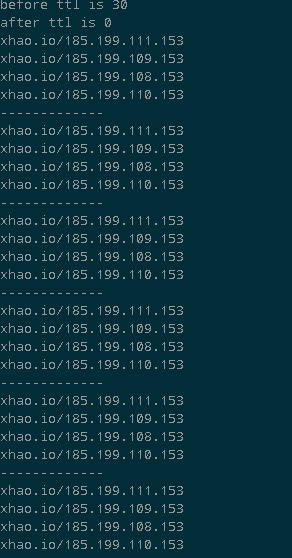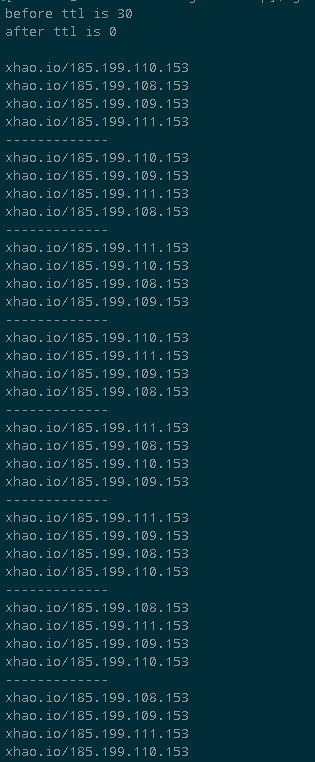在现在流行的服务化调用场景中,为了避免服务的单点问题,会将服务部署成一个集群,然后利用服务注册中心来解决服务发现问题。
为了解决服务注册中心的单点问题,有时候会选择古老的dns轮询。
通过将一个域名关联多条A记录,利用域名服务器每次的不同返回,达到软负载的效果。
关于jdk的dns解析,网上有很多文章介绍,有对的地方也有错的。
1 2 3 4 public ChannelFuture connect (String inetHost, int inetPort) return connect(new InetSocketAddress(inetHost, inetPort)); }
这段代码入参是hostname,获得socket连接,在InetSocketAddress中自动完成了dns的工作——InetAddress.getByName(hostname)
jdk中dns查询分2步完成,首先是检查addressCache;如果没有发现,则触发一次网络dns查询。
InetAddressCachePolicy是address的缓存,默认是30s的缓存时间,可以通过networkaddress.cache.ttl来修改。这个cache有这样几个特点:
如果你通过security property的方式设了值,则在运行期不可以修改
如果运行期修改ttl,不能比以前小
从代码上猜测,主要是因为dns查询本身损耗性能,加入这种安全限制,能避免三方库随意设置,导致应用出现瓶颈。
如果想在运行期自由控制dns缓存时间,就只能通过反射这种方式了
1 2 3 4 5 6 7 8 9 10 11 12 13 14 15 16 17 18 19 20 public class Test public static void main (String[] args) throws Exception try { Field f = sun.net.InetAddressCachePolicy.class.getDeclaredField("cachePolicy"); f.setAccessible(true ); int cache = (int ) f.get(sun.net.InetAddressCachePolicy.class ) ; System.err.println("before ttl is " +cache); f.set(sun.net.InetAddressCachePolicy.class , 0) ; cache = (int ) f.get(sun.net.InetAddressCachePolicy.class ) ; System.err.println("after ttl is " +cache); } catch (NoSuchFieldException | SecurityException | IllegalArgumentException | IllegalAccessException e) { } while (true ){ Arrays.asList(InetAddress.getAllByName("xhao.io" )).forEach(System.out::println); System.out.println("-------------" ); Thread.sleep(5000L ); } } }
ok,当我们将ttl换成0之后,跑跑看,会发现在不同的机器上结果不一样。
macos high sierra
CentOS Linux release 7.5.1804
因为我们已经调整了dns缓存的时间,所以每次打印的结果都是通过dns查询得来的。
但是在mac上感觉ip顺序是固定的,而centos上却是无序的;换句话说,在mac上无法实现dns轮询,而centos上还可以。具体原因是什么呢?关于这个,查阅了一些资料,但都说的不清楚,有一个可能性是关于RFC 3484
getaddrinfo : The sorting function used within getaddrinfo() is defined in RFC 3484; the order can be tweaked for a particular system by editing /etc/gai.conf (available since glibc 2.5).
网上一些关于RFC 3484的说明是:
给ip排序的目的是想尽量使用ipv6,方便ipv6设备的推广
应该少依赖dns轮询,这不可靠
ip排序有一定的规则,会实现与否要看本地库(这只是建议,不强制)
在mac上并不打算继续追查这个问题了,偷懒认为它是按照标准实现的。但是linux上,可以用trace工具看看getaddrinfo的逻辑。所以找了台机器跑一跑下面的程序:strace ./a.out
1 2 3 4 5 6 7 8 9 10 11 12 13 14 15 16 17 18 19 20 21 22 23 24 25 26 27 28 29 30 31 32 33 34 35 36 37 38 39 40 41 42 43 44 45 46 47 48 49 50 51 52 #include <netdb.h> #include <stdio.h> #include <stdlib.h> #include <string.h> int main (int argc, char *argv[]) struct addrinfo hints , *res = NULL ; char *host = "xhao.io" ; memset (&hints, 0 , sizeof (hints)); hints.ai_flags = AI_CANONNAME; hints.ai_family = AF_UNSPEC; int getaddrinfo_error = getaddrinfo(host, NULL , &hints, &res); if (getaddrinfo_error) { printf ("fail %s" , gai_strerror(getaddrinfo_error)); } else { struct addrinfo *iterator = res; char prev[100 ], addrstr[100 ]; void *ptr; while (iterator != NULL ) { if (iterator->ai_family == AF_INET) { ptr = &((struct sockaddr_in *)iterator->ai_addr)->sin_addr; } else { ptr = &((struct sockaddr_in6 *)iterator->ai_addr)->sin6_addr; } inet_ntop(iterator->ai_family, ptr, addrstr, 100 ); if (strcmp (prev, addrstr) != 0 ) { printf ("Ipv%d is %s\n" , iterator->ai_family == AF_INET ? 4 : 6 , addrstr); strncpy (prev, addrstr, 100 ); } iterator = iterator->ai_next; } } return EXIT_SUCCESS; }
我们会发现结果和jdk中的结果相同,基本可以判断并没有之前所说的排序过程。
同时我们还发现,jdk是调用了系统命令来查询dns,这和我们在jdk源码中看到的差不多(jdk这部分代码有一大坨,看起来只是在整理和排序)
我们还发现getaddrinfo是一个很重的命令,因为它每次都会去发请求到dns服务器上,并没有任何缓存。这应该就是jdk自己做了缓存的原因,毕竟每次都查询dns服务器,对性能是有影响的。
关于java dns相关的,大概就是这些内容了。总之dns轮询不一定可靠,需要慎重对待。

